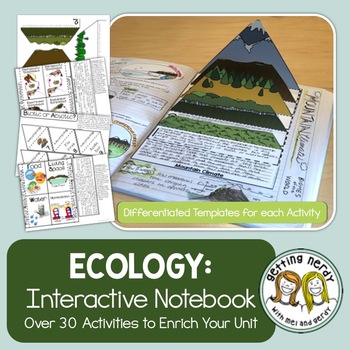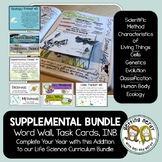Science Interactive Notebook - Ecosystems and Ecology Activities
- Zip
- Google Apps™

What educators are saying
Also included in
- Engage your students with over 200 Interactive Notebook activities in digital google and regular format for all of your life science needs. Our interactive notebook flippers will have your kids "flipping" their way to learning all about cells, genetics, evolution and more! Use these activities as stPrice $95.95Original Price $113.60Save $17.65
- Unit Lesson Plans complete with guiding PowerPoint and student pages? ✓Word walls? ✓ Interactive Notebooks? ✓Task Cards? ✓You're ready to teach with this comprehensive bundle for teaching Ecology and Ecosystems. Engage your students with our animated PowerPoints and aligned lessons, 30+ InteractivePrice $124.95Original Price $155.35Save $30.40
- Word walls? ✓ Interactive Notebooks? ✓Task Cards? ✓You're ready to teach with this comprehensive bundle to supplement your life science curriculum. Engage your students with over 200 Interactive Notebook activities, a year-long visual word wall with roots, suffixes and prefixes AND English and SpaniPrice $169.95Original Price $218.25Save $48.30
Description
Engage your students with over 30 Interactive Notebook activities and digital Google Slides for all of your ecology unit needs. Our interactive notebook flippers will have your kids "flipping" their way to learning all about organisms interect with one another and their environment. Disseminate these lessons as you see fit through creating a PowerPoint, in a class discussion or as small group activities. The possibilities are endless!
WHAT'S INCLUDED IN THIS LESSON:
• 135+ pages (30+ activities) of NON-EDITABLE activities in PDF format including differentiated templates in black-line and color covering the following topics:
→ Intro to ecology and ecosystems
→ Needs lof living things
→ Levels of ecological organization
→ Abiotic versus biotic factors
→ Food webs and food chains
→ Trophic levels and energy pyramids: producers, consumers and decomposers
→ Types of ecological interactions: competition, predation, symbiosis
→ Types of competition
→ Mountain ecosystems
→ Biome distribution
→ Types of biomes and ecosystems
→ Cycles in nature: water, carbon, nitrogen
→ Succession
→ Human impact
→ Native versus non-native species
• Directions for each activity
• Answer keys
• Absent student pre-filled answer sheets
• Examples of each activity
DIGITAL GOOGLE CLASSROOM links to all items listed above which can be easily converted to Microsoft School with directions provided or altered to fit your school’s personal learning management system
STUDENTS WILL:
• Cut out, fill in and color the templates
• Complete each activity individually, in pairs or in groups
THIS PRODUCT IS ALSO FOUND IN OUR:
• Life Science Interactive Notebook Bundle
• Life Science Interactive Notebook Complete Bundle
CHECK OUT OUR OTHER INTERACTIVE NOTEBOOK LESSONS:
• Lab Report Templates for Interactive Notebook
• Genetics - Interactive Notebook
• Evolution - Interactive Notebook
• Human Body Systems - Interactive Notebook
• Cells Organelles & Processes Interactive Notebook Activity Pack
• Classification of Living Things - Interactive Notebook Activity Pack
• End of Year Interactive Notebook Activities
SEE HOW THIS LESSON ALIGNS WITH THE NGSS, TEKS or GSE
TERMS OF USE (TOU):
All rights reserved by GETTING NERDY®️
• This product is to be used by the original purchaser only
• Intended for classroom and personal use only
• Copying for more than one teacher, classroom, department, school, or school system is prohibited
• This product may not be distributed or displayed digitally for public view
Failure to comply is a copyright infringement and a violation of the Digital Millennium Copyright Act (DMCA). Clipart and elements found in this PDF are copyrighted and cannot be extracted and used outside of this file without permission or license.
Interactive Notebook: Ecology and Ecosystems © 2012 to present Getting Nerdy ®️ All Rights Reserved
www.gettingnerdyscience.com








